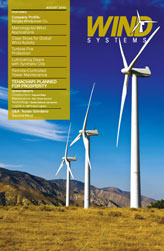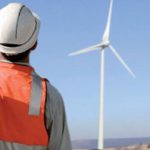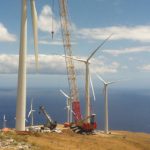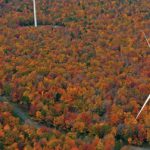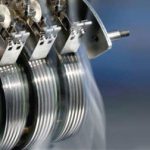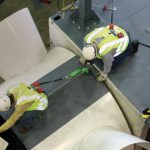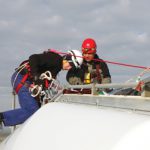The outlook for M&A—mergers and acquisitions—activity in the wind energy sector is positive following a return to health in the second half of 2009 and 2010, according to a report by VB/Research. Wind is now established as the most mature renewable energy market, and it will be a major beneficiary of the continued drive by global governments to increase their domestic renewable energy capacity.
These conclusions are based on a worldwide survey of more than 250 senior executives active in the renewable energy industry conducted by KPMG and VB/Research, a specialist provider of renewable energy data, intelligence, and research. The survey was conducted between January and March 2010 and was completed by five different types of respondents: corporates, financial investors, debt providers, government bodies, and service providers. Among the respondents 75 percent were top-level executives such as chairpersons, senior executives, or divisional heads. Surveyed respondents were split among Western Europe (33 percent), North America (29 percent), and Asia-Pacific (18 percent), with Eastern Europe, Middle East and Africa, and South America accounting for the remaining. This research was supplemented by interviews with senior top-level executives from across the whole range of renewable energy sectors.
Signs of Recovery
In 2008 and early 2009 the effects of the financial crisis meant funding for new renewables projects slowed dramatically as lenders withdrew from the risky end of the market. The second half of 2009 and 2010 recorded a major increase in deal flow and volume. In the first quarter of 2010, global deal volume in the renewables sector increased by 245 percent. Wind was a major contributor to this recovery as the largest single renewable market, accounting for deals valued at $1.8 billion, just ahead of the $1.5 billion recorded for solar. This total was boosted by two big Iberian deals, with Enel and Iberdrola recently announcing investments of €860m and €320m, respectively, in wind assets in Spain. Deal flow has been steady since the report was completed in April. Since then the Brazilian investment fund Caixa Econômica Federal and the Argentine electricity provider IMPSA have invested $225 million to acquire a 45-percent stake in Brazilian wind generation power plant developer Energimp, while private equity firm Platina Partners have paid $95 million to buy 52 French wind farms from Infigen Energy. The wind technology sector has also been active in Asia, where the Chinese company Galaxy Semi-Conductor Holdings acquired the wind power equipment manufacturer Power Full Group Holdings through a deal worth $106 million.
Along with the two Spanish giants, other large project buyers in the wind sector over the last 18 months included the UK’s Renewable Energy Systems, Ireland’s Bord Gais Eireann, and North America’s NextEra Energy Resources. The U.S. also saw positive growth, as total wind energy capacity grew by 39 percent throughout 2009. The market in the States has been invigorated by an upsurge in wind investments from large utilities, such as Kansas-based Westar Energy’s acquisition of the development rights to a 500-MW wind project from Infinity Wind Power in January 2010.
The UK has been one of the greatest beneficiaries from the first wave of heavy government stimulus. The British government’s 2009 budget announced a series of support measures aimed at stimulating renewable energy projects including £525m for offshore wind farms through the Renewable Obligation scheme. Since this announcement a series of transactions have taken place as developers have sought to reduce their risk and attract third-party capital to their offshore wind commitments. Notable transactions included investment company TCW’s acquisition in October 2009 of a 50-percent stake in Centrica’s Boreas portfolio (total installed and projected capacity of 206-MW) along with a refinancing of the project. At the end of 2009, DONG Energy and Siemens Project Ventures acquired a 50-percent stake in Centrica’s 270-MW Lincs project. DONG Energy also announced the sale of a minority stake in its 367-MW Walney offshore wind farm project to Scottish & Southern Energy. The UK remains a highly attractive market boasting the largest wind resources in Europe and a well-defined subsidy regime.
Wind technology is lagging behind the sector at large. It has been impacted by weakening demand in the wind turbine market. The deep backlogs in turbine orders that were commonplace in early 2009 have been replaced by rapidly shrinking orders as the 2008 drop in project financing for developers filtered through to turbine manufacturers in the second half of 2009. Industry players have responded to this trend by reducing their exposure to the sector. For example, Iberdrola divested 10 percent of its holding in Gamesa for over €391.7m in a private placement in June 2009. Later in the year, AE Rotor received £224m for its 35 percent share in Hansen Transmissions, while United Technologies acquired a 49.5 percent stake in Clipper Windpower for £166m.
Government Incentives
The failure to achieve a global agreement on emissions targets at the UN Climate Change Conference in Copenhagen last November will not dent M&A activity in the renewables sector, according to 88 percent of the KPMG/VB Research survey respondents. In the absence of a standardized global structure, regional government incentives and initiatives will be employed to boost renewable investment. Significantly over half of the surveyed respondents predict that these regional regulations and tariffs will accelerate M&A activity during the next 18 months. The most prominent such incentive is the U.S. American Recovery and Reinvestment Act (ARRA), which came into effect in early 2009 and, combined with subsequent stimulus measures, has made North America the preferred geography for acquisitions of renewable energy projects or companies. Almost half of the European and a third of the Asia-Pacific respondents are considering acquisition targets in North America in the next 18 months.
However, the market is keenly aware that such government support is of limited size and duration, and that it must generate activity independent of these incentives. Cord Landsmann, CFO at E.ON Climate and Renewables GmbH, says, “We aim in the long run to achieve grid parity without subsidies… we would not choose locations with poor or uncertain access to the energy source, even though they could benefit from important incentive-based regimes.” Other drivers of cross-border M&A in the sector include energy security in the form of reliable energy supply and secure production facilities; volatile fossil fuel prices; market consolidation; and increasing demand within society for a renewable/alternative energy supply. M&A deals will also be boosted by financial backers looking to exit their current portfolio companies. Venture capital investors who reached their investment limit during the downturn by providing follow-on financing to their portfolio companies, and funds that were raised over five years ago are desperately looking to exit some of their investments. With the IPO market still fragile, M&A is the most attractive exit route.
Government incentives, coupled with more liquid capital markets, will ensure that both corporates and investors approach 2010 with a greater focus on M&A. According to VB/Research’s survey, more than 90 percent of respondents are considering M&A activity in the next 18 months, compared to an equivalent report from 2009 when 45 percent of the surveyed respondents were either not planning to make any acquisitions during the following 12 months or were undecided. Thirty-six percent of respondents said they are targeting acquisitions in the wind sector.
Bolstering Technology Capacity
Corporates will target acquisitions that increase generation capacity, leaving technology and equipment company acquisitions to investors. Landsmann says that “We follow our boutique to industrial approach and target projects based on scalable technologies that can provide synergies, and reduce costs. The wind sector is at an advanced stage of development and provides such characteristics, while the solar sector is the next to follow with a huge potential of scalability.”
As the most mature renewable energy sub-sector, synergistic technology acquisitions and downstream integration is less critical to corporates active in the wind sector. Financial investors are expected to be the major players in takeovers and investments in technology and equipment companies. Few of the surveyed corporates plan to acquire onshore wind technologies and equipment or onshore wind management and installation companies during the next 18 months, whereas investors are expected to be more active in these markets, driving efficiency savings through market consolidation.
“The onshore wind sector started its consolidation in 2002-2003, but there is still room for deals to be done. If further consolidation does not take place over the next 18 months some companies will disappear,” according to Anil Srivastava, CEO of Areva Renewables. Institutions such as pension funds and sovereign wealth funds will facilitate the access to finance for highly capital-intensive industries such as the offshore wind sector, where single projects can require in excess of €1 billion of capital expenditure.
Alongside these financial investors, the institutions that will be most active in the next 18 months are large corporates with strong balance sheets and an international presence, enabling them to pursue deals without needing to secure additional debt finance. An overwhelming majority of survey respondents (77 percent) expect specialist renewable energy companies and subsidiaries of integrated utilities to be the most active participants.
Access to Debt Markets
There is more good news for the wind sector thanks to an improvement in the disposition of debt providers. After a period during which the debt markets virtually ground to a halt, banks are now set to become slightly less risk-averse. A third of the surveyed debt providers indicated an intention to increase their exposure to the sector in the next 18 months. Onshore wind warms are viewed as the most risk-free proposition for these entities. Seventy-five percent of those surveyed stated that they were interested in financing onshore wind farm projects. However, debt financing will be harder to come by for wind technology companies: 25 percent of the surveyed debt providers said they would be interested in providing solutions to that sub-sector.
Debt financing should be easier to raise in 2010. However, the case for asset financing needs to be stronger than they may have been pre-2008. As Srivastava notes, “Prior to the crisis, renewable energy was an industry of announcements, announcements of projects that would not be feasible to build. Today contractors are required to have a real ability to execute and a large balance sheet.” Another symptom of the banks’ continued caution is that they are still not inclined to approve debt tenures beyond 15 years. Margins for debt financing have also risen considerably. An onshore wind project in Europe is now financed at an average rate of 300 basis points (bps) over the base rate, compared to 100 bps in 2007.
This means that equity financing remains critical to financing efforts in the renewable space. The survey indicates that North Americans are the most confident of tapping these markets, as 32 percent of respondents from the region indicated their confidence that they can access this form of financing. Although traditional financing sources are reopening, financing M&A transactions may not be straightforward. Acquirers in the sector may well need to continue to find creative financing arrangements to bring their renewable plans to life.



















